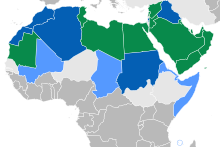Standard Arabic
Modern Standard Arabic (MSA; Arabic: اللغة العربية الفصحى al-lughah al-ʻArabīyah al-fuṣḥá 'the most eloquent Arabic language'), Standard Arabic, or Literary Arabic is the standardized and literary variety of Arabic used in writing and in most formal speech. It is considered a pluricentric language.
Most Western scholars distinguish two standard (al-)fuṣḥá (الفصحى) varieties of Arabic: the Classical Arabic (CA) (اللغة العربية التراثية al-lughah al-ʻArabīyah al-turāthīyah) of the Quran and early Islamic (7th to 9th centuries) literature, and Modern Standard Arabic (MSA) (اللغة العربية المعيارية الحديثة al-lughah al-ʻArabīyah al-miʻyārīyah al-ḥadīthah), the standard language in use today. MSA is based on classical Arabic, and differences between the two varieties of the language are directly related to modernizing and simplification, both in speaking and writing styles. Most Arabic speakers consider the two varieties to be two registers of one language, although the two registers can be referred to in Arabic as فصحى العصر fuṣḥá al-ʻaṣr (MSA) and فصحى التراث fuṣḥá al-turāth (CA).
Classical Arabic, also known as Quranic Arabic (although the term is not entirely accurate), is the language used in the Quran as well as in numerous literary texts from Umayyad and Abbasid times (7th to 9th centuries). Many Muslims study Classical Arabic in order to read the Quran in its original language. It is important to note that written Classical Arabic underwent fundamental changes during the early Islamic era, adding dots to distinguish similarly written letters, and adding the Tashkeel (diacritical markings that guide pronunciation) by Abu al-Aswad al-Du'ali, Al-Khalil ibn Ahmad al-Farahidi, and other scholars.
...
Wikipedia


